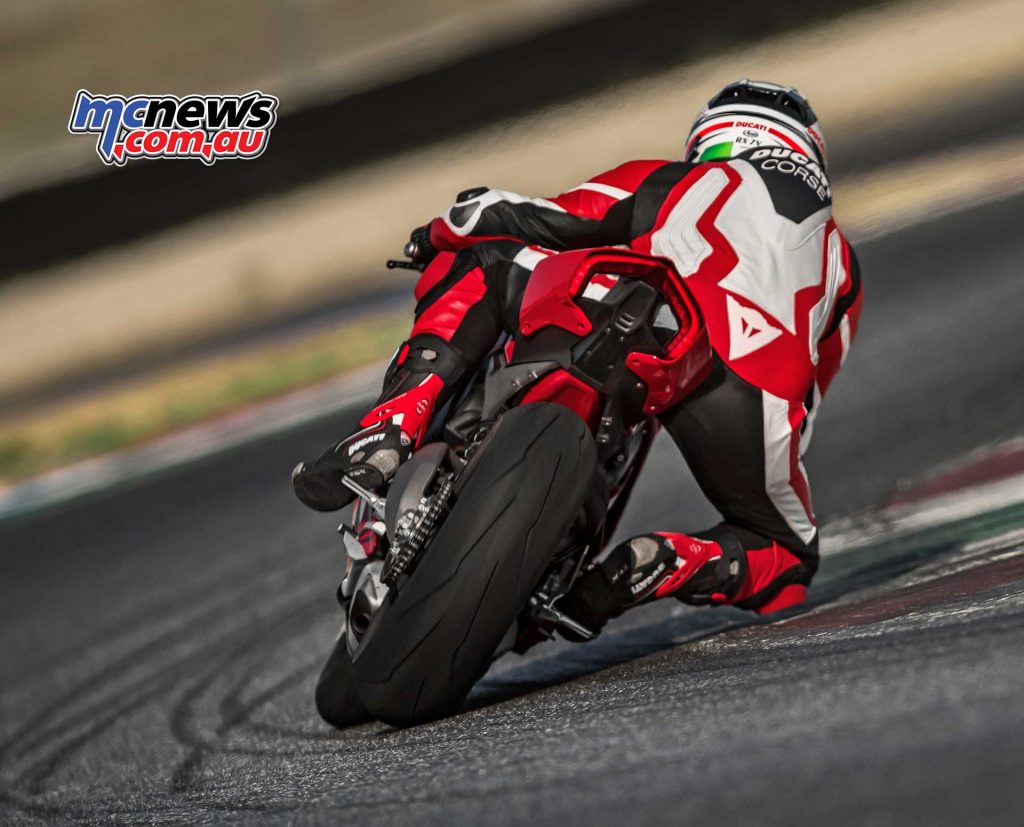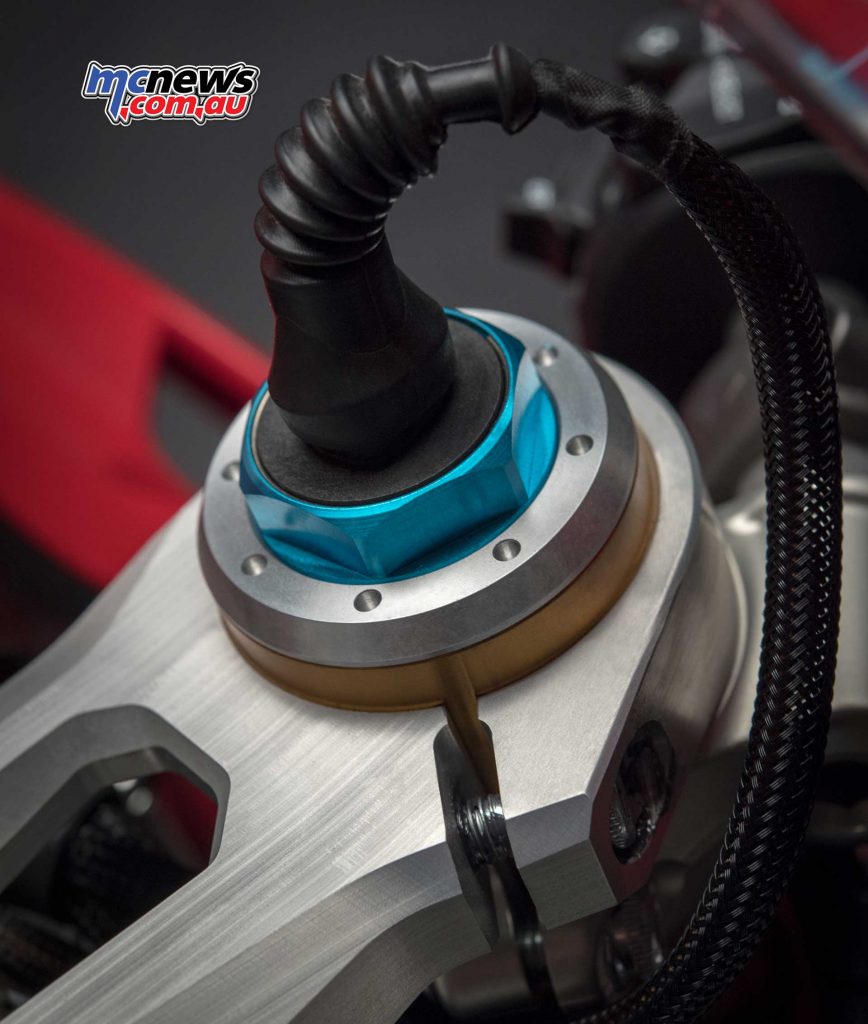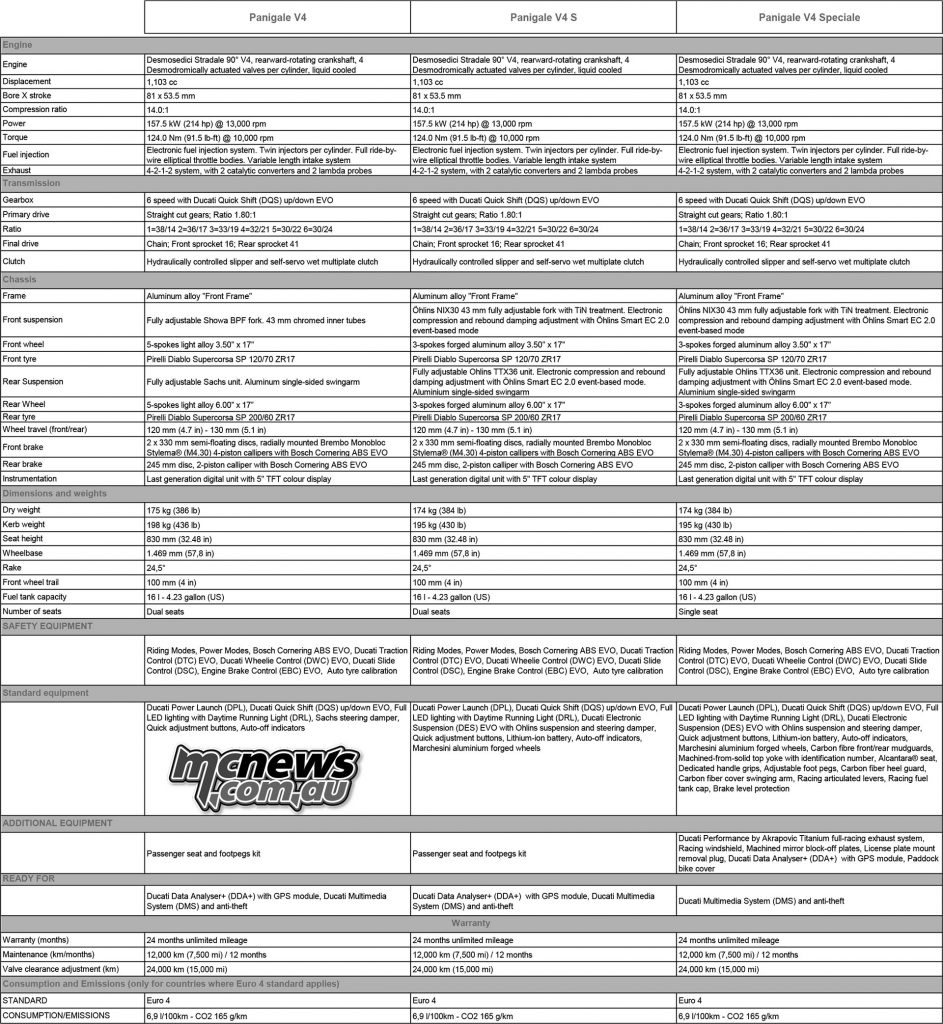Latest-generation electronic controls
The Panigale V4 not only sets new benchmarks in terms of top performance, but also defines new active safety standards and vehicle dynamics control – thanks to a state-of-the-art electronic package, based on the use of a 6-axis inertial platform (6D IMU – Inertial Measurement Unit) that instantly detects the motorcycle’s roll, yaw and pitch angles in space.
The Panigale V4 electronic package includes controls to ensure management of all the riding phases; some of these control the start, acceleration and braking phases, others manage traction, while others kick in when riding into and out of corners.
- ABS Cornering Bosch EVO
- Ducati Traction Control EVO (DTC EVO)
- Ducati Slide Control (DSC)
- Ducati Wheelie Control EVO (DWC EVO)
- Ducati Power Launch (DPL)
- Ducati Quick Shift up/down EVO (DQS EVO)
- Engine Brake Control EVO (EBC EVO)
- Ducati Electronic Suspension EVO (DES EVO)
The operating parameters of each control are factory-associated with the three Panigale V4’s signature Riding Modes. The rider can customise his or her riding style and restore Ducati’s factory settings. The level of one of the DTC, DWC, DSC or EBC control functions can be quickly adjusted via the direct access buttons provided on the left-hand switchgear.

ABS Cornering Bosch EVO
The Bosch ABS system, equipped with a “Cornering” function that extends ABS action to situations in which the vehicle is leaning in corners, has undergone a major evolution to reflect the latest action logic and types of control.
Level 3 is indicated on the road or for low-grip conditions, ensuring safer and more stable braking, levels 2 and 1, the hard-braking options, are more suited to higher grip surfaces and track racing. Selecting level 2 enables the rider to skid into corners safely, enhancing racing performance.
The ABS Level 1, recommended for track riding, is activated while maintaining the “Cornering” feature – for extremely hard braking into corner and to help rectify any rider mistakes.
Ducati Traction Control EVO (DTC EVO)
The DTC EVO featured by the Panigale V4 is based on an algorithm that makes intervention faster and more accurate. The DTC EVO interfaces with the Bosch Inertial Measurement Unit (IMU), constantly monitoring the vehicle’s lean angle and using it to accurately calculate the degree of intervention needed to ensure suitable rear wheelspin (according to the DTC EVO level setting).
Moreover, the DTC EVO also acts on the throttle body valves and controls spark and injection advance. In all situations in which fast intervention of the DTC EVO is not required, the use of the throttle body valves ensures maintenance of optimal combustion parameters, ensuring a smoother Desmosedici Stradale response and system intervention.
With simpler types of traction control, detection of rear wheelspin sees the system kick in to hold it in check. When optimal grip is re-established, the system reduces intervention until spin reoccurs, and the cycle repeats. This produces a graph that shows intervention oscillating around a theoretical “ideal intervention line” that represents the traction limit. The DTC EVO reduces the magnitude of those oscillations, making the system operate closer to the perfect intervention line. This kind of behaviour is highly advantageous as
its effect on the dynamic balance of the motorcycle is minimal. In addition, the system is designed to be stronger and more consistent, allowing the motorcycle to maintain constant and predictable behaviour even when the grip level changes – i.e. in case of rear tyre wear.
In addition to this enhanced intervention precision, when set to level “1” or “2”, the DTC EVO introduces a new function, named “spin on demand”, allowing the rider to control the motorcycle up to levels that would previously only have been possible for experts or pros.
Now, when the machine is leaned over, the rider can use the throttle to request more wheelspin than that obtained at the normal intervention level, allowing the
motorcycle to pivot around its front wheel and close the cornering line. The DTC EVO allows riders to do this while keeping safety parameters under control, effectively letting them ‘close’ the cornering line with the rear wheel.
Ducati Slide Control (DSC)
The introduction of the 6D IMU has allowed the Ducati Slide Control (DSC) – developed in conjunction with Ducati Corse – to be added to the Ducati Traction Control EVO (DTC EVO). This new system provides the rider with further support by controlling the torque delivered by the Desmosedici Stradale engine as a function of the slide angle; its goal is to improve out-of-the-corner performance by preventing slide angles that might otherwise be difficult to handle. The DSC relies on the 6D IMU that provides the vehicle control
unit with crucial information on vehicle dynamics (such as lean angle, acceleration and much more). Thanks to these data – and depending on the user-selected level – the DSC extends the performance range of the motorcycle for everyone, providing improved assistance under extreme riding conditions.
Like the DTC EVO, the DSC controls torque reduction by acting on the throttle body valves, spark advance decrease and injection cuts. In every situation in which fast intervention of the DSC is not required, the use of the throttle body valves ensures optimal combustion parameters, with a smoother Desmosedici Stradale engine response and system intervention.
The DSC has two different settings: switching from level 1 to level 2 results in easier control of slide angles that would otherwise be difficult to handle. DSC intervention levels can be changed by accessing a special menu, in which DTC EVO and DWC EVO values can also be set. It is also possible to set direct DSC control via the direct access buttons on the left-hand switchgear. The DSC setting is always shown on the display.
Ducati Wheelie Control EVO (DWC EVO)
The Panigale V4 also comes equipped with the latest version of Ducati Wheelie Control EVO (DWC EVO).
This system, using Bosch 6D IMU information, ensures wheelie control to obtain top acceleration performance in a smooth, safe manner. The DWC EVO detects the occurrence and extent of wheelies to control them with a higher level of precision – ensuring a more accurate response to rider input.
Ducati Power Launch (DPL)
This 3-level adjustable system ensures lightning-fast starts, letting the rider focus only on releasing the clutch. Once set, the rider simply engages the first gear and opens the throttle. During the first stage of starting off, while the rider is modulating the clutch release, the DPL stabilises the Desmosedici Stradale at optimal revs as a function of the selected DPL level. In the second phase, when the clutch has been fully released, the DPL controls torque delivery to ensure the maximum degree of acceleration according to the
chosen level.
The DPL makes use of the DWC functions and always keeps the DTC active to ensure maximum safety at all times. Automatic deactivation of the system occurs above the end-of-start speed, or once third gear is selected. To protect the clutch, a specially developed algorithm allows only a limited number of consecutive starts. The number of available starts resets itself when the rider uses the motorcycle normally.
The DPL is adjustable to three different levels, and is activated by pressing the special button on the right handlebar. Level 1 favours high-performance starts, level 3 is safer and more stable.
Ducati Quick Shift up/down EVO (DQS EVO)
The DQS EVO with up/down function, developed for the Panigale V4, compared to the previous Panigale 1299 system uses the information concerning the lean angle to maximise motorcycle stability when shifting gears in corners.
The DQS EVO, as well as minimising gear shifting times, allows down-shifting without using the clutch – ensuring even more effective hard braking. The system consists of a two-way microswitch built into the linkage of the gear change lever; each time that the gearbox is actuated, it sends a signal to the Desmosedici Stradale ECU. The system works differently for upshifts and downshifts, integrating adjustment of the spark advance and injection during upshifts with a controlled opening of the throttle valve during
downshifts – ensured by the full Ride-by-Wire system management.
The extent and duration of system operation are designed to ensure seamless gear meshing even under extreme track riding conditions; during downshifts the system works synergetically with the slipper clutch and the Engine Brake Control (EBC).
Engine Brake Control EVO (EBC EVO)
The EBC (Engine Brake Control) system has been developed to help riders optimise vehicle stability under extreme turn-in conditions, by balancing the forces applied to the rear tyre under severe Desmosedici Stradale engine-braking conditions. The Panigale V4 EBC EVO, optimised on the basis of the lean angle, monitors the throttle position, selected gear and crankshaft deceleration rate under heavy braking and finetunes
throttle opening to balance the torque forces acting on the tyre. The EBC EVO can be set to three levels integrated in the Riding Modes.
Ducati Electronic Suspension EVO (DES EVO)
The “S” and Speciale versions are equipped with the event-based electronic control Öhlins suspension system, based on the second-generation Öhlins Smart EC (Electronic Control) system which, in addition to leveraging all the potential offered by the 6D IMU, has a new and more intuitive rider interface, OBTi (Objective Based Tuning Interface).

The electronic suspension offers the choice between manual mode (“Fixed”) – allowing compression, rebound, and damping of the steering damper to be manually set via “virtual clicks” (32, from fully open to fully closed, for the suspension, and 10 for the shock absorber) – and automatic (“Dynamic”).
When the “Dynamic” mode is selected, based on the information received from the 6D IMU and other sensors, the system automatically adjusts compression and rebound damping in response to the riding style.
The main advantages offered by the Öhlins Smart EC 2.0 system concern the rider’s option to customise the level of intervention on the suspension, depending on individual riding events (braking, cornering, acceleration), as well as to adjust the operating parameters of individual hardware components. For the rider, this means having access to a superior level of motorcycle dynamics control – improving road safety and track lap time efficiency.
New Ducati Riding Mode strategy
The Riding Modes allow the rider to choose from three different factory-set riding styles, perfectly adapting the Panigale V4’s behaviour to the rider’s, to the track type, and to environmental conditions. Each Riding Mode is programmed to instantly change the engine’s character, electronic control parameters and, in the “S” and “Speciale” versions, also the suspension set-up. Each rider can customise his or her riding style and later restore Ducati’s factory settings.
Riding Mode Race – As the name implies, the Race RM has been developed for experienced riders who wish to make the most of all the potential of the Panigale V4 on high-grip track surfaces. By selecting Race, the rider can rely on 214 HP, with direct Ride-by-Wire throttle response and, on the ‘S’ and Speciale versions, a high-performance hard suspension set-up. The Race mode implies a low-intervention default electronics setting, without, however, compromising on safety, with the ABS only intervening on the front
wheel to provide maximum braking performance, but with the Cornering feature always active.
Riding Mode Sport
By selecting the Sport Riding Mode, the rider can count on 214 HP power delivery with a sporty Ride-by-Wire response to throttle opening and, in the S and Speciale versions, an equally sport-oriented suspension set-up. Electronic controls are set in such a way as to help also less experienced riders adopt an effective, highly spectacular riding style. In the Sport mode, for instance, the controlled braking drift feature is active, allowing for safe wheel skidding when turning into corners. The rear wheel lift
control function is active and the ABS Cornering function is set to provide maximum cornering performance.
Riding Mode Street
The Street Riding Mode is the one recommended for road use of the Panigale V4. This RM offers the rider 214 HP power delivery with progressive Ride-by-Wire response to throttle opening, like in the Sport RM, and, in the Panigale V4 S and Panigale V4 Speciale versions, an extremely soft suspension set-up to absorb any bumps in the road. The default setting of electronic controls helps ensure maximum safety, by guaranteeing the best grip and stability.
Second generation TFT display instrumentation
Ducati was the first motorcycle manufacturer to fit a model, the 2012 1199 Panigale, with full-TFT (Thin Film Transistor) colour display instrumentation.
Six years later, with the Panigale V4, Ducati sets a new standard by launching an advanced 5″ full-TFT, high-res (186.59 PPI – 800xRGBx480) and high-brightness colour display, completely redesigned in terms of lay-out and up-to-date graphics, and even more alluring. In developing the motorcycle’s instrumentation, the main focus was on readability and easy access to functions.
The most visible element of the brand new dashboard is the “virtual” circular rev-counter, located on the right side, a clean break with past equipment tradition, inspired by high-end automotive production. The Desmosedici Stradale revs are displayed in the 1,000 to 15,000 rpm range via a needle indicator, whose motion is highlighted by a white trail acting as a “shiftlight”, changing from white to orange and then going red when approaching the over-rev area.
Two different layouts are available to – and can be recalled by – the rider: the “Track” display, which focuses attention on the lap time indication and in which the rev counter scale highlights the engine rpm values related to the track-specific range of use; and the “Road” display, which instead of lap times, shows Ducati Multimedia System (DMS) information, and highlights engine rpm values typical of road riding. For improved
readability, the indications of the (digital) top speed, selected Riding Mode, and selected gear do not change position when the selected lay-out is changed.
The Panigale V4 dashboard, in addition to the classic menu including total kilometres, Trip 1, Trip 2, fuel consumption, average fuel consumption, Trip Fuel, Trip Time, Average Speed, Air Temperature, Lap On/Off (in “Track” mode only), and Player On/Off (in “Road” mode only), also features another menu in the bottom right corner with two available functions: display/indication of parameters related to the selected Riding Mode or quick changing of DTC, DWC, EBC and DSC parameters. Finally, the Panigale V4 has an “auto
off” function for its direction indicators: the indicators will go off automatically after riding out of a corner or, if pressed unintentionally, after a few hundred metres on a straight stretch (variable between 200 and 2000 metres depending on the current speed of the vehicle when the indicator button is actuated).
Ducati Lap Timer GPS (DLT GPS)
The DLT GPS allows lap times to be automatically recorded, stored and displayed directly on the dashboard each time the finish line is crossed – providing the rider has previously entered the finish line coordinates, by pressing the light flasher button. The system has a useful “Best Lap” feature that displays the lap time flashing for 5 seconds if it is the best recorded lap time in the current track session. For each lap, and for a total of 15 consecutive laps, the lap time, max rpm and top speed are stored; this information can be viewed on the dashboard by accessing the special menu. The DLT GPS is part of the standard equipment on the Panigale V4 Speciale and is available as a Ducati Performance plug-and-play accessory for the Panigale V4 and Panigale V4 S.
Ducati Data Analyser + GPS (DDA + GPS)
The Ducati Data Analyser + GPS (DDA + GPS), evaluates the performance of the motorcycle and its rider by graphically presenting specific channels of information. The DDA + GPS is an essential piece of equipment for track use: it monitors the rider’s performance, in addition to automatically recording and displaying lap times whenever the Panigale V4 crosses the start and finish line. It stores a number of data channels including throttle opening, vehicle speed, engine rpm, gear selection, engine temperature, distance
travelled, revs and DTC index. DDA + GPS is available as a Ducati Performance plug-and-play accessory, while it is supplied as standard with the Speciale.
Ducati Multimedia System (DMS)
The Panigale V4’s versatility is demonstrated by a pre-setting for the Ducati Multimedia System (DMS) – allowing the rider to accept incoming calls, select and listen to a music track, and receive SMS notifications thanks to Bluetooth technology.
When the rider gets on the motorcycle, his or her smartphone automatically connects to the vehicle via Bluetooth, allowing the rider to handle the main multimedia features. The TFT display shows the played track, the icon indicating new incoming SMS or the name of the caller. The call or music sound are transmitted to the rider’s helmet earphones. The DMS is available for the entire Panigale V4 range as an accessory.

[/vc_column_text][/vc_column][/vc_row]























